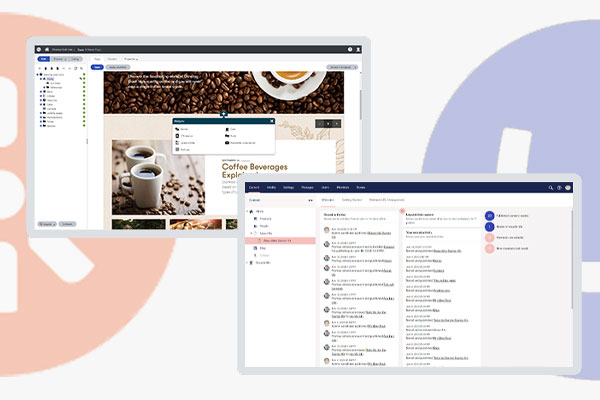There's a lot of information about both systems on our site, but which one do we actually recommend? Let's take a closer look at the two popular .NET-based content management platforms. We will try to compare them in terms of functionality, user-friendliness, support, and pricing.
To make things clear right away, Kentico and Umbraco are both excellent digital platforms, and it shouldn't surprise anyone that we start with that statement. We work with both systems on a daily basis, and we are a Kentico Gold Partner, as well as Umbraco Partner. This article isn't about pointing out "the winner" but instead providing you with some guidance in choosing the one better suited for your business needs.
There are already plenty of Kentico/Umbraco side-by-side comparisons published online. Therefore, we will not go deep into technical details that only web developers care about but rather present these systems from the perspective of the people who will use them and benefit from them - content creators and business owners.
The variety of templates
How often do you get the feeling of deja vu while visiting a website or an online shop you just googled for the first time? Probably quite often. That's because web designers love to reuse the same beloved templates with “a bit of personal touch”. Template-based websites are easy to put together and manage. You choose the design you like and fill it with content. However, ease of development is not necessarily the case to be made for the systems we discuss today since both are known primarily for their customizability. So you have to decide if you want your website to be unique and not give users deja vu or spend considerably less time to simply have it up and running
While Kentico provides its users with access to a couple of pre-designed templates, making it somewhat easier to shape the website, Umbraco does not offer any ready-to-use templates from the start. However, Umbraco is a little more flexible because it allows developers to upload pre-designed templates in the form of CSS and HTML files. So, if you want to use elements from, let's say, your previous WordPress page, there is a way to do it with your Umbraco page.
Kentico also provides you with controls to build your very own custom template without any add-ons required.
Content management
Both CMS platforms give a lot of flexibility. Kentico allows users to create different custom page types and structure content in many ways. Adding a custom code is relatively straightforward, thanks to the system's framework. Once you set the guidelines, content entry becomes very easy. You can use the built-in WYSIWYG editor, which works just like any text editor, allowing you to insert media, conveniently link between pages, and format your text in any way you like.
Content management is pretty similar in the case of Umbraco. Still, one cool feature the platform offers is the ability to integrate its editor with your desktop Microsoft Word application and produce your content even if you're offline.
E-COMMERCE SOLUTIONS
The E-commerce module provided by Kentico allows you to set up an online shop and easily (and safely) integrate it with authorization features and payment gateways. In addition, the built-in e-mail marketing automation module is a fantastic asset for online sellers. It allows you to create marketing scenarios for your clients directly in the Kentico dashboard. For example, without additional plugins or external tools, you can automatically remind your customers about their next purchase or send promotional codes to the most active users.
Meanwhile, Umbraco has several e-commerce solutions available, the most recognized being uCommerce, one of the leading .NET selling platforms. A highly flexible e-commerce environment that a skilled developer can easily tailor to fit many different scenarios and create a seamless customer journey. It allows you to manage a variety of products and cross-channel selling.
SEO
Search engine optimization is not something separate from web development. You should think about it from the moment you start building the website. Fortunately, both platforms provide you with a nice set of SEO features. For example, with Umbraco CMS, you can completely control all the SEO on-page components, meaning title tags, URL structure, alt-texts, etc. Kentico, on the other hand, features a couple of SEO-related functionalities. For example, it gives users access to sitemap, 301 redirects, and enables them to build custom URLs.
Support
Both platforms provide users with guides, full documentation, and multi-language support. However, suppose you like to rely on help from an online community. In that case, you should know that the Umbraco community is very active and responsive, whereas that is not necessarily the case with the Kentico community. On the other hand, Kentico professional support is much more available and can provide you with a solution to the reported problem within 7 days.
Whichever CMS you choose, the best option is to rely on your web development services provider anyway. And as a software house specializing in Kentico and Umbraco development, we offer our partners custom maintenance plans, full support, and fast reaction in case of crashes or other problems with your website.
Pricing
Kentico is meant mainly for the upper-mid market and enterprise-level digital solutions. Umbraco is basically for anyone from small businesses to enterprises.
Umbraco is open-source, so it doesn't require any licensing fees. However, the free platform means it comes without additional tools you will have to integrate. Not to mention the cost of support, maintenance, and all the developers' work.
Kentico has a free version, but it obviously comes with constraints. The annual license fee for the "Business" option for Kentico 13 is $11 000 per year, including content management and e-commerce tools. "Enterprise" plan "for next-level websites with digital marketing capabilities" costs from $19 900 per year.
Summary
Each platform is excellent in its own way. It may not be the perfect metaphor, but we like to think of Kentico as this multi-functional, feature-packed device that can do almost everything you ask for, whereas Umbraco is more like a LEGO set you can build an identical device with.
If you are looking for security, automation, ease of use, and a bit more regimented service, Kentico is the right choice. However, Umbraco needs more knowledge and experience to utilize its full potential, but with the right approach, it can profit your business in extraordinary ways.
As always at the end of our articles, we invite you for a free consultation with a senior developer. There are way too many aspects to be considered while choosing CMS, and a Discovery session will be the perfect opportunity to discuss them.





